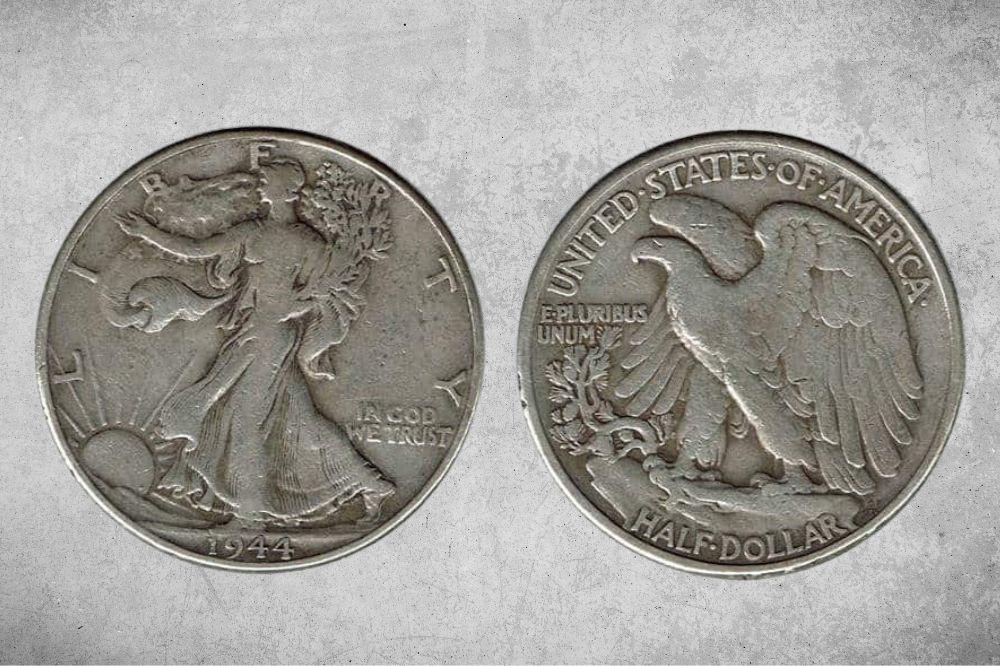Do you have a 1944 Half Dollar in a drawer somewhere in your house? Are you interested in numismatics? Or are you just looking to kill some time reading about an exciting subject?
Well, you have come to the right place – expect to learn almost everything there is to be learned about the 1944 Half Dollar. Let’s go!
1944 Half Dollar Details
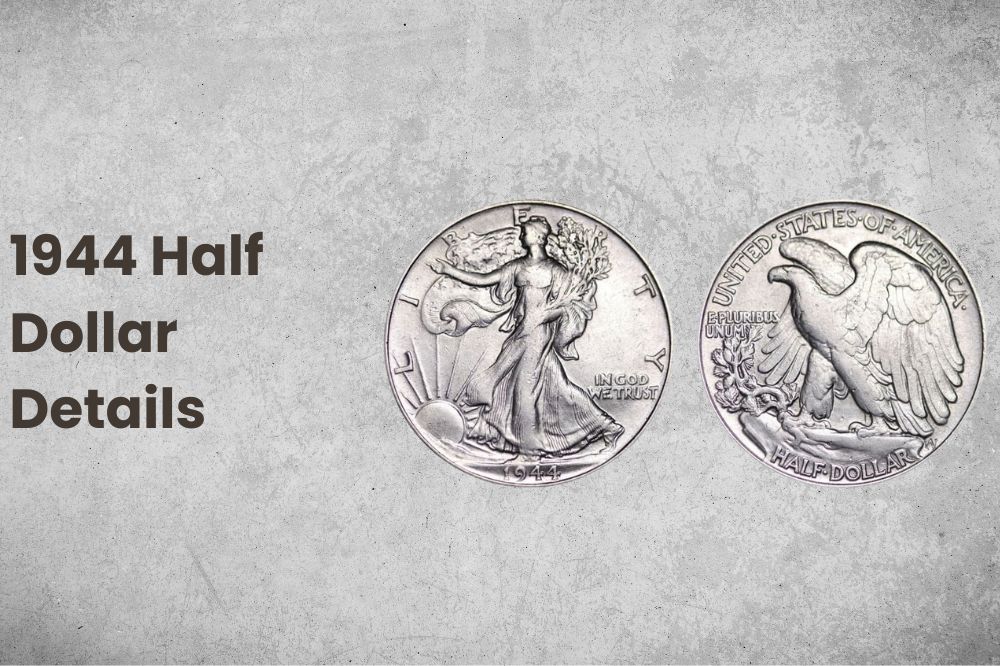
- Category: Half Dollar (1916 – 1947)
- Mint(s): Philadelphia, Denver, San Francisco
- Mintage: 46,879,000
- Obverse Designer: Adolph A. Weinman
- Reverse Designer: Adolph A. Weinman
- Face Value: 50 cents ($0.50)
- Composition: 90% silver – 10% copper
- Weight: 0.440 oz (12.50 g)
- Diameter: 1.205 in (30.63 mm)
- Thickness: 0.070 in (1.8 mm)
- Edge: Reeded
- Fineness: 0.9
- ASW: 0.361 oz
- Melt Value: $8.21
Obverse
The term liberty is no stranger to any person or nation, especially those who had to fight for it. The USA is one of those nations, which is why it surprises probably no one why they used it on their coins as a writing and drawing.
The term liberty is a term that the designer of the 1944 Half Dollar, Adolph A. Weinman, obviously loved because he used it not only on this coin but on another one he designed, the Mercury Dime.
Mercury Dime and Half Dollar feature a Lady Liberty on their obverses, but while it is known that the person on Mercury Dime was Weinman’s neighbor and the wife of American poet Wallace Stevens, Elsie Stevens, the identity of the person on Half Dollar is not known for sure.
Some people claim that Weinman depicted Elsie on the Half Dollar as well, some say that he drew inspiration from the Lady Liberty that Oscar Roty portrayed on his design for French coins, and there are also those who are of the opinion that the person is not real.
Whatever the truth may be, the Lady Liberty and the whole ensemble on the obverse make this coin’s design truly breathtaking. The American flag dances and flickers on Liberty’s shoulders while she walks towards the sun, which is depicted on the obverse’s bottom left side.
For this reason, the Half Dollar is widely known as Walking Liberty Half Dollar.
Lady Liberty is pointing to her left with her right hand and holding oak and laurel branches, which represent civil and military strength and the victory of the American people, in her right arm.
The obverse side’s design is completed with the inscription LIBERTY, which is found along the rim of the top half of the coin, the motto IN GOD WE TRUST, which is located on the right side next to Lady Liberty’s leg, and the year 1944, which, of course, represents the date when this coin was struck.
Reverse
The reverse side is no less spectacular, thanks to a bald eagle standing on a mountain crag with outstretched wings. The bald eagle has been a long-established national symbol in the US that is used to represent strength, freedom, independence, and pride.
It is interesting to note that Weinman previously used a bald eagle on the reverse of the American Institute of Architects medal. There are two major differences between the designs, however.
The eagle on the medal is looking down and tearing a branch of laurel, while the one on the Half Dollar is looking up to the sky.
The other difference is the branch type – on the Half Dollar, Weinman used mountain pine, which can be seen on the left side of the bottom half of the coin arising from the rock.
Above the mountain pine is the Latin writing E PLURIBUS UNUM, meaning “Out of Many, One”, while the inscription UNITED STATES OF AMERICA can be found along the top rim of the coin’s reverse. The bottom one features the writing of the denomination, HALF DOLLAR.
The 1944 Half Dollar has two more elements – next to HALF DOLLAR’s R can be seen the designer’s monogram, while the mint mark on coins struck in Denver and San Francisco is on the bottom left side beneath the mountain pine and left to the crag.
1944 Half Dollar Value Chart |
||||
| Mint Mark | Good | Fine | Extremely Fine | Uncirculated |
| 1944 No Mint Mark Half Dollar | $16 | $19 | $21 | $41- $57 |
| 1944 D Half Dollar | $15 | $19 | $21 | $47 – $68 |
| 1944 S Half Dollar | $15 | $20 | $21 | $47 – $74 |
1944 Half Dollar Value And Varieties Guide
1944 Half Dollar had a total coin production of 46,879,000 pieces carried out in three mints: Philadelphia, Denver, and San Francisco.
If we count December of 1941 as the official date when the United States entered World War 2 due to the attack by the Japanese on Pearl Harbor, the 1944 Walking Liberty had the lowest mintage in the war years (1942 – 1945).
Almost 47 million coins minted make the 1944 Half Dollar not so uncommon. However, it is still slightly more desirable compared to the other Half Dollars from the same era due to the aforementioned low production.
1944 No Mint Half Dollar Value
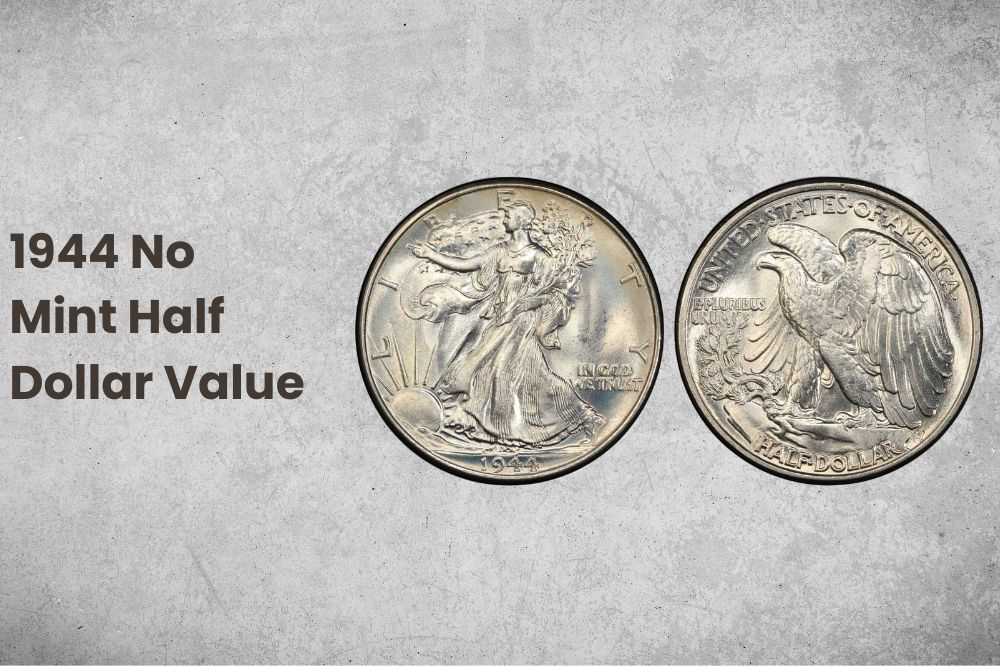
- Type: Half Dollar
- Mint: Philadelphia, Denver, San Francisco
- Mintage: 28,206,000
- Mint Mark: No mint mark
- Designer: Adolph A. Weinman
- Face Value: 50 cents ($0.50)
- Composition: 90% silver – 10% copper
- Weight: 0.440 oz (12.50 g)
- Diameter: 1.205 in (30.63 mm)
- Thickness: 0.070 in (1.8 mm)
- Edge: Reeded
- Fineness: 0.9
- ASW: 0.361 oz
- Melt Value: $8.21
28,206,000 1944 No Mint Half Dollars were struck in the Philadelphia mint. You can find them for $16 in a good state, $19 in a fine state, and $21 in an extremely fine state.
The uncirculated ones are worth at least double the extremely fine ones since their price range is between 41 and 57 dollars.
One interesting thing about 1944 No Mint Walking Liberty Half Dollars is that even though they were produced in the highest amount, which is common for coins struck at the mint in Philly, they are worth the most money when we look at some of the auction records.
In fact, a coin of this kind in MS68 was sold for a whopping 109,250 dollars in 2010.
1944 D Half Dollar Value
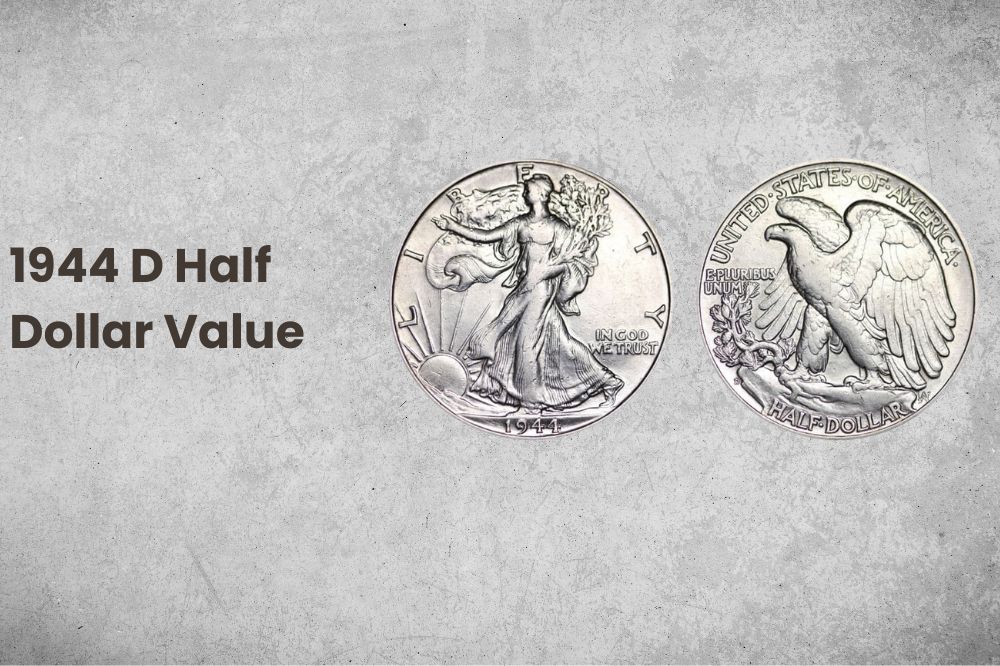
- Type: Half Dollar
- Mint: Denver
- Mintage: 9,769,000
- Mint Mark: D
- Designer: Adolph A. Weinman
- Face Value: 50 cents ($0.50)
- Composition: 90% silver – 10% copper
- Weight: 0.440 oz (12.50 g)
- Diameter: 1.205 in (30.63 mm)
- Thickness: 0.070 in (1.8 mm)
- Edge: Reeded
- Fineness: 0.9
- ASW: 0.361 oz
- Melt Value: $8.21
Almost 10 million 1944 D Half Dollar coins were minted in Denver, making it almost three times less common than the ones minted in Philadelphia. Still, the prices of this coin variety are almost the same as the ones from the city of brotherly love.
The only meaningful differences can be seen in the uncirculated category and auctions.
1944 D Half dollars in the uncirculated category are usually sold in the range from $47 to $68.
Only 4 of these coins were sold on auctions for more than 10,000 dollars, while the No mint mark specimens have 8 entries when we use the same constraint.
1944 S Half Dollar Value
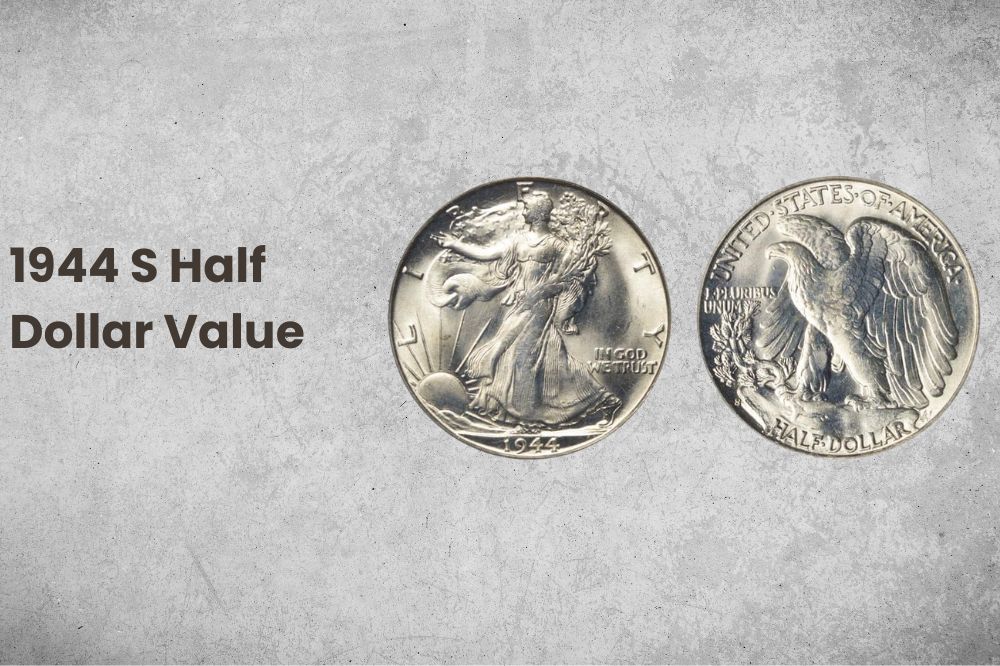
- Type: Half Dollar
- Mint: San Francisco
- Mintage: 8,904,000
- Mint Mark: S
- Designer: Adolph A. Weinman
- Face Value: 50 cents ($0.50)
- Composition: 90% silver – 10% copper
- Weight: 0.440 oz (12.50 g)
- Diameter: 1.205 in (30.63 mm)
- Thickness: 0.070 in (1.8 mm)
- Edge: Reeded
- Fineness: 0.9
- ASW: 0.361 oz
- Melt Value: $8.21
Much of what we wrote in the last part goes for the 1944 S Half Dollar.
Its worth is similar to the 1944 No mint mark Half Dollars despite the huge difference in the mintage (28,206,000 to 8,904,000), with major dissimilarities appearing in the uncirculated category ($41 – $57 range for the No mint mark ones, $47 – $74 for the San Francisco specimens) and on the highest levels.
The most that a coin of this type has gone for is $40,800, which happened in June of 2021 when a specimen in mint state 67 was sold at the US Coins auction.
1944 Half Dollar History
It is funny how life works sometimes.
Probably the only reason why the Half Dollar and several other coins came to be is the personal belief of the then newly appointed Mint Director, Robert Wolley, that coin designs had to be changed since, in 1915, they were already in use for 25 years which is the minimum amount of time that has to pass before the US Mint can change the designs without the congressional authorization.
If he did not hold this belief, who knows how many more years would have passed with coins featuring the old designs.
The old designs were the work of the long-time Mint Engraver Charles Barber, and the dime, quarter, and half dollar were the coins that had it. They were so popular that these three coins were known under one name: Barber coinage.
Robert Wolley got his way regarding another thing that concerned the designs of the three coins. Before the redesign, dime quarter and half dollar had nearly identical motifs and arrangements, which he wanted to change by making each of them unique.
Even though Wolley gave Barber the first opportunity to redo the designs, the Commission of Fine Arts, which Wolley appointed to pick the new designs, did not like the sketches that Barber submitted.
After this, the Commission chose three sculptors, Hermon MacNeil, Albin Polasek, and Adolph Weinman, to try their luck at the task. Two of five sketches Adolph Weinman submitted were accepted, and he was selected to make the new designs for the dime and half dollar.
MacNeil would go on to recreate the quarter.
Even though Weinman’s designs were different from the ones Barber’s coinage features, he still used the same motifs as Barber did with his designs – Lady Liberty on the obverse and the bald eagle and several other national symbols of the United States on the reverse.
The Walking Liberty Half Dollar, which was the name given to this coin since the Lady Libert is depicted walking towards the sun on the obverse, and two other redesigned coins were released into circulation in the last quarter of 1916.
Despite the astounding obverse and reverse, Half Dollar was the coin to get the least amount of love and publicity, with the Mercury Dime being in the clear first in these regards.
Still, the Mint claimed that the three mints where Half Dollars were struck experienced difficulties meeting the public’s demand.
The Walking Liberty Half Dollar was used until 1947 when it was replaced by the Franklin Half Dollar, which was made to honor one of the United States Founding Fathers, Benjamin Franklin.
1944 Half Dollar Grading
If you want to learn how to grade Walking Libert Half Dollars, please refer to this video!
List Of 1944 Half-Dollar Errors
The 1944 Walking Liberty Half Dollar does not have many errors. We will only mention three that deserve to be talked about here. Let’s look at each of them!
1. 1944 Half Dollar Hand Engrained Monogram Of The Designer (AW)
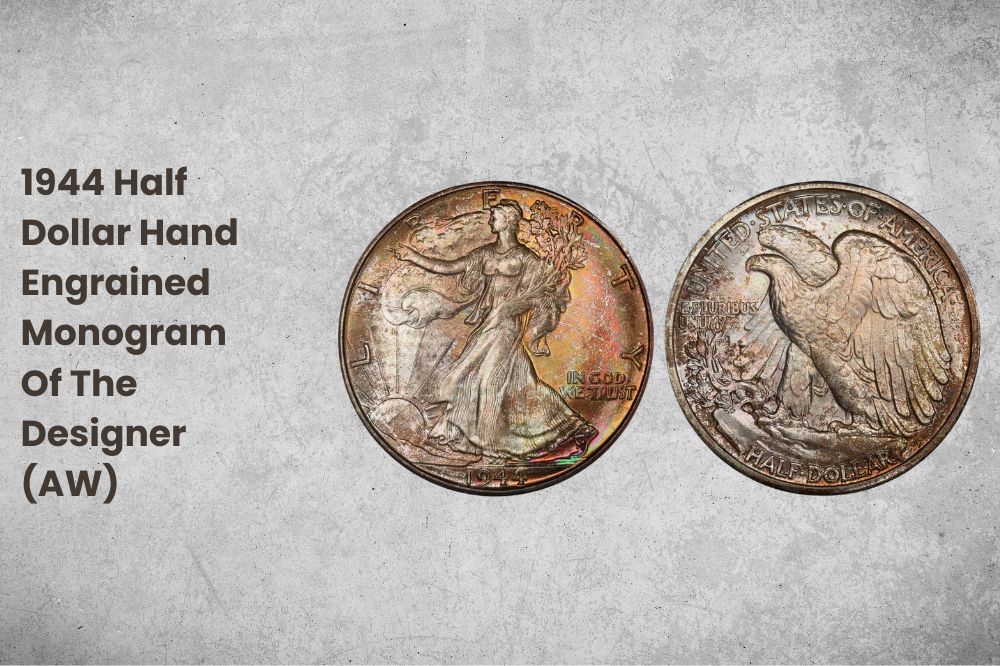
Some people consider this to be a variety of the 1944 Half Dollar, while others say it is an error. In either case, some coins that were struck at the mint in Denver in 1944 did not have the designer’s monogram on them, which is why the initials had to be engrained by hand into them.
If you manage to get your hands on one in, for example, MS 65, you can expect to earn as much as 160 dollars!
2. 1944 Half Dollar Without Monogram Of The Designer (AW)
While there are coins that had either punched or hand-cut initials, there are also coins that did not have either of those, i.e., they were struck without the AW monogram.
Similarly to the ones from the previous section, some people consider the coins with this error to be a variety of the 1944 Half Dollar.
3. 1944 Half Dollar Repunched S Mint Mark Error
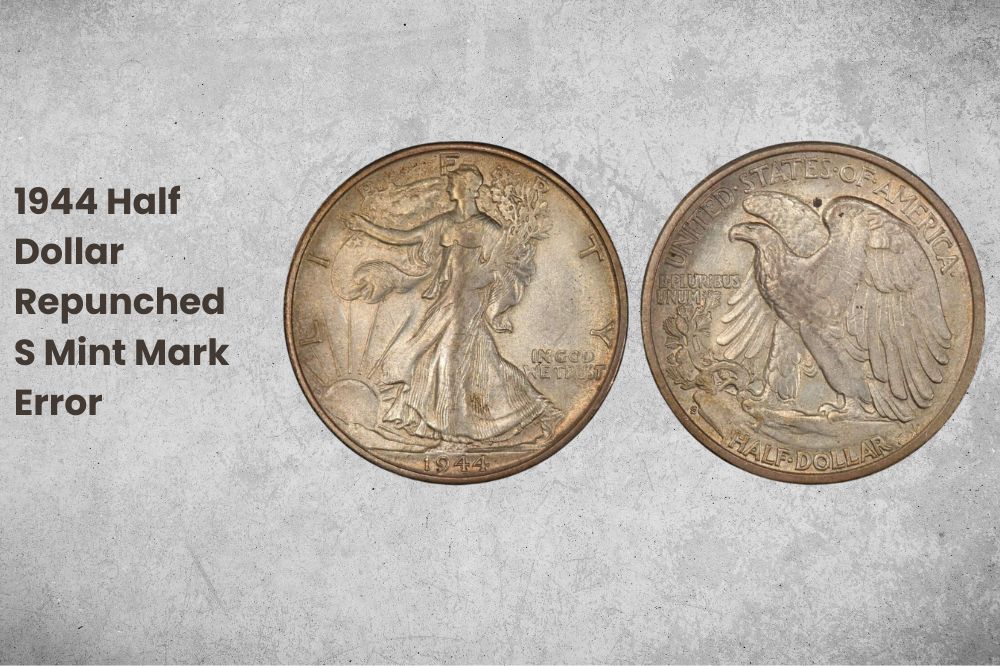
The last error we will discuss in this article is the repunched mint mark, courtesy of the mint in San Francisco.
This error is quite common in almost all coin productions, but that will not stop you from earning almost 300 dollars for a specimen with it that is in great condition.
1944 Half Dollar FAQ
How much is a 1944 half-dollar worth in silver?
1944 Half Dollar’s worth in silver, also known as melt value, is $8.21.
Are 1944 Half Dollars worth anything?
1944 Half Dollars are worth quite some money. Even in the lowest-mint states, they are worth around 15 dollars. Uncirculated ones are at least $40, while the best of the best are regularly priced in the thousands.
What makes a 1944 half-dollar rare?
1944 Half Dollar was produced in not-so-small quantities, so it is not rare by itself. What makes it rare are mint errors such as the hand-cut monogram, punched S mint mark, and the absence of the monogram from the reverse.
